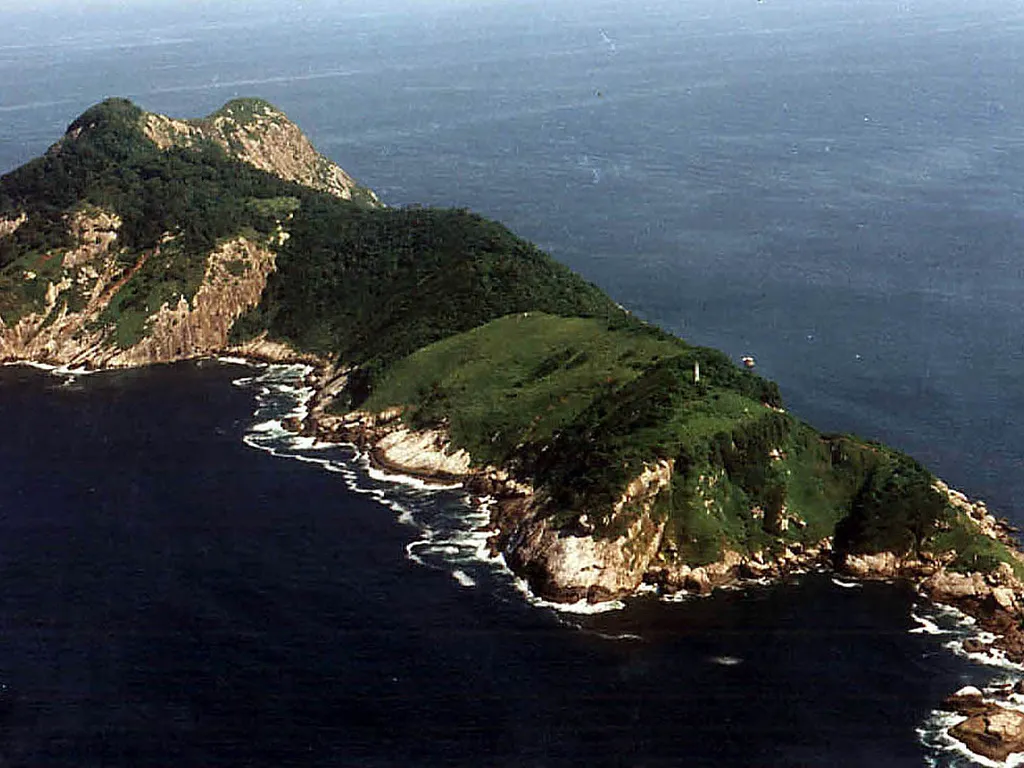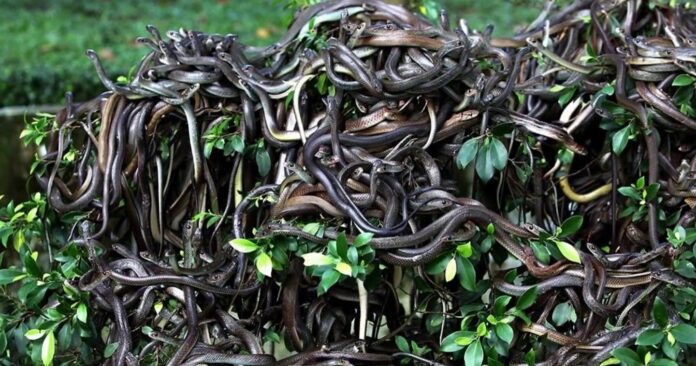This small tropical island is located just 35 km off the coast of the state of São Paulo, Brazil. This green paradise could have become a bustling tourist hotspot if it weren’t for one thing: the picturesque piece of land is literally teeming with venomous snakes. Thousands of wild reptiles have completely displaced humans and have been the dominant species here for over a century. Only a solitary lighthouse stands as evidence that the territory was once inhabited.
The length of the snake’s lair is 1.67 km, and the width is up to 600 m. The island is situated at an elevation of 206 m above sea level. Interesting facts about Snake Island Queimada Grande: Half of Queimada Grande is covered by dense forests, while the rest is barren rocky terrain. The rocky coastline is very steep, making it difficult to dock. The waves gradually erode the shores, causing soil collapses and making many coves inaccessible.
The island is located in the subtropical zone. The average temperature in March is +27 degrees Celsius, and in August it is +18. The wettest period is December, with rainfall reaching 135.2 mm, while the driest is July, with no more than 2 mm of rainfall per month.
There is a theory that about 9,000 years ago, this piece of land was connected to the mainland by a narrow isthmus through which reptiles reached the island. Then the isthmus disappeared underwater, leaving the snakes cut off from the continent.

How to get to Snake Island Queimada Grande? Tourist boats go to the vicinity of the island from the major port city of Santos. You can reach this town by bus from São Paulo, the capital of the Brazilian state of the same name.
Why is Queimada Grande included in the list of the most extreme places on the planet? Magnificent jungles, clean water, breathtaking views of the Atlantic Ocean — this corner seems perfect for luxury hotels, but its colonization history is very sad. In the early twentieth century, Brazilian businessmen decided to cultivate banana plantations on Queimada Grande.
They brought in workers, but they were constantly attacked by venomous snakes. Attempts to burn down the lush thickets along with the annoying creatures led to nothing, and the animals became much more aggressive. Plantation owners found another way out: they provided the staff with sturdy rubber suits, but it was impossible to wear them constantly due to the hot climate. As a result, the reptiles emerged victorious.
At the highest point of the “Death Island” stands a lighthouse, built in 1908. All its keepers died after encounters with the native inhabitants of Queimada Grande; the last of them perished along with his family. Initially, people managed to keep the snakes out of the lighthouse’s territory, but eventually, they too fell victim to the merciless creatures. Since the 1920s, the lighthouse has been automated. The Brazilian Navy carries out annual maintenance of the equipment, with sailors descending to the shore while observing strict safety measures.
Visiting Queimada Grande is strictly prohibited. To observe the snake-infested cliffs through binoculars, one can take a leisurely boat tour.
The Brazilian government occasionally issues special permits for scientists to research the island. Serpentologists’ work is not enviable: besides hordes of aggressive killers, they face other challenges such as heat, high humidity, impassable jungles, and countless insects. A mandatory requirement for obtaining a pass is to have a doctor accompany the expedition.
The island lancehead viper (Bothrops insularis), also known as the golden lancehead snake, belongs to the viper family and is found only on Queimada Grande. Estimates show that there are about 5,000 of them on the island.
These reptiles prefer to inhabit jungles, climb trees and bushes with ease. They can be found on rocks and sand as well, constantly moving in search of food. The average length of the snake is about a meter, and its coloration is golden, light brown, or yellowish, with dark square or triangular spots on the sides. The head is quite massive, and the body is slender. Females are significantly larger than males. Unlike other vipers, these snakes have a long but not overly prehensile tail, which helps them climb trees.
The venom of the island lancehead viper is so concentrated that it dissolves flesh. Tissue necrosis develops, leading to gastrointestinal bleeding and acute kidney failure. Without antivenom, a fatal outcome is highly likely.
Despite the complete absence of natural predators for the lancehead viper, scientists report a gradual decline in their population due to severe food shortages and a range of other factors. Predators have long since destroyed all small rodents, and now they depend on the seasonal migrations of birds. The venom of the golden lancehead snake is five times more toxic than that of mainland lanceheads, directly related to the shrinking food base. Catching a bird is quite difficult; it needs to be killed quickly, or else you’ll be left without lunch.
Queimada Grande is a stopover for dozens of migratory bird species, unaware of the imminent deadly danger. The diurnal reptiles lurk for hours, hiding in the branches and swiftly attacking their prey. They have long, foldable fangs for injecting venom. Besides birds, the island snakes feed on scorpions, spiders, insects, frogs, and even their own kind. Non-venomous snakes of the Dipsas albifrons species have been found on the island, and especially hungry monsters consume other lancehead vipers.
Queimada Grande is the world’s largest natural serpentarium. The lost island in the ocean is the only habitat of the golden lancehead snake. It has been listed in the IUCN Red List as a rare species in need of protection. The number of individuals is steadily declining, and there are several reasons for this. The area of tropical forests is decreasing. Some plantations have been cleared by humans, and it will take many years for them to recover. Sporadic wildfires are also common, destroying everything in their path. Any disturbance affects the natural reproduction of the lancehead vipers.
Another threat to the reptiles is poachers who, at the risk of their own lives, have taken to catching valuable specimens and selling them on the black market. It turns out that the venom of these animals possesses medicinal properties.
Ecologists succeeded in designating the unique piece of land as a special territory in 1985, and now it is a veritable natural terrarium. Specialists study the flora and fauna, monitoring the population of the endangered reptile species. To prevent the complete disappearance of these animals, plans are underway for their breeding in captivity.
There are many chilling legends about the mysterious doomed place. One of them claims that bloodthirsty asps were brought to Queimada Grande by pirates who decided to hide their boundless treasures here. The monsters were supposed to guard the gold from unwelcome guests. The snakes multiplied and took over the entire land.
